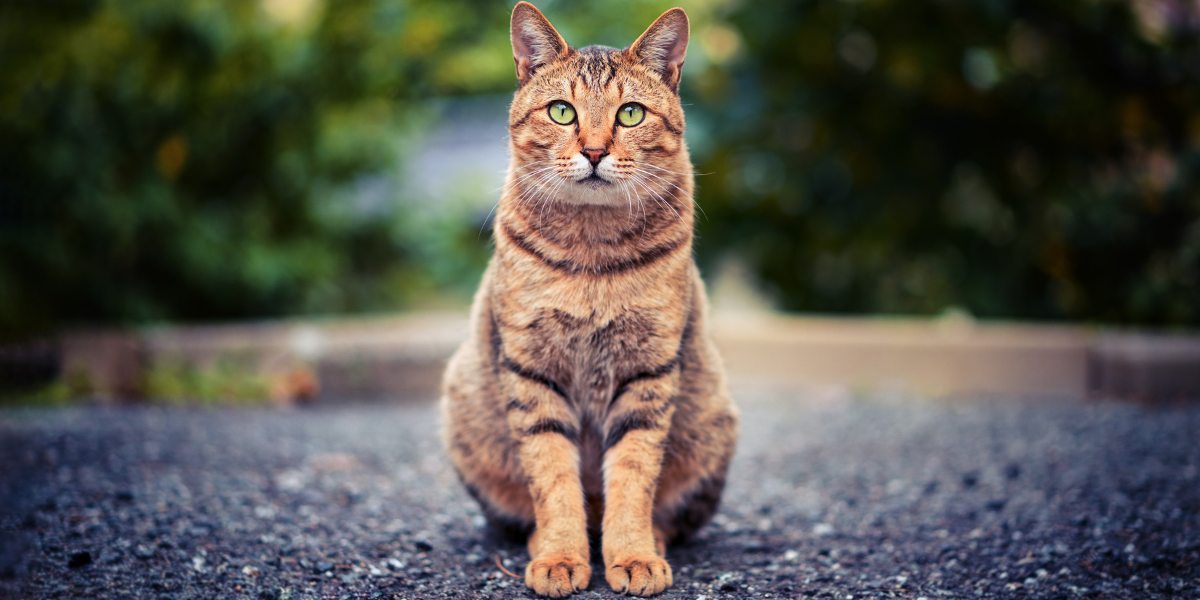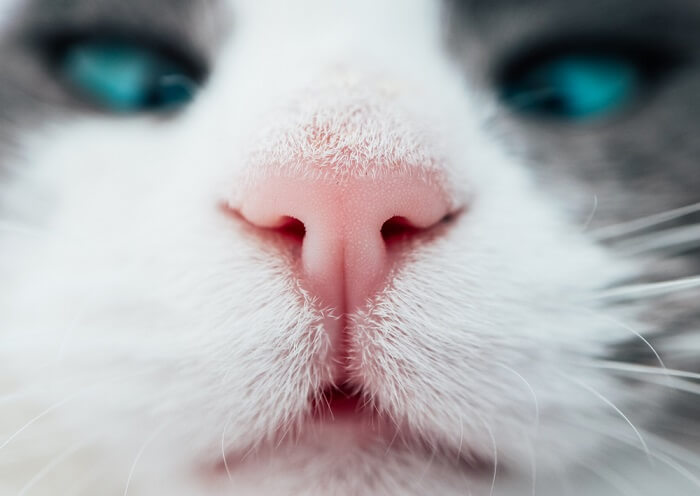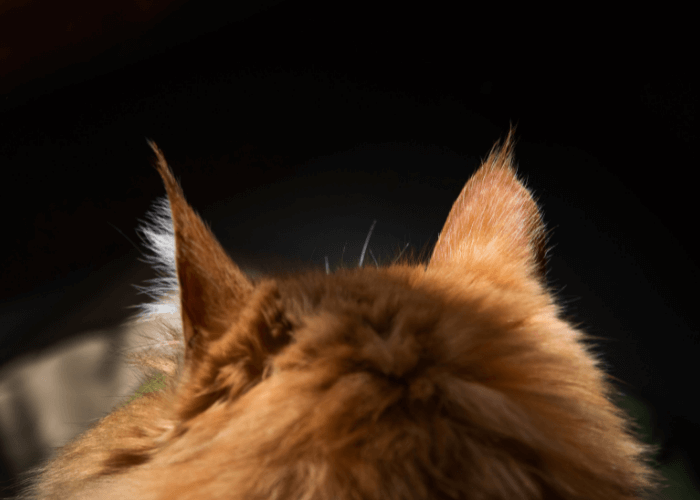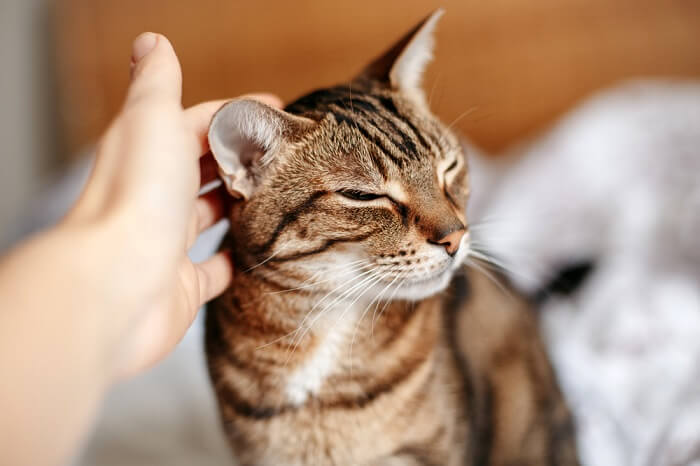
Between snoozing in sunny spots on the floor and full-speed sprints in the middle of the night, your cat hopefully has a comfortable and rewarding lifestyle.
Cat owners do their best to provide everything their feline friends need to stay happy and healthy. The key to this task is understanding how your cat views the world and how their five senses influence their everyday lives.
What Senses Do Cats Have?
No matter how connected you feel to your cat, it’s important to remember that cats have significantly different biological needs and functions when compared to humans. Their senses of smell, sight, taste, hearing, and touch affect how they experience the world around them.
Here’s a basic breakdown of how your cat’s senses sight, hearing, smell, taste and touch influence their life experiences and how those experiences impact your relationship.
1. Smell

About 40 times more powerful than a human nose, your kitten’s cute button nose is a major source of information.
A cat’s sense of smell is one of their strongest super powers. About 40 times more powerful than a human nose, your kitten’s cute button nose is a major source of information.
Cats use their sense of smell for a long list of essential purposes. With a single sniff, your cat can determine if their food has gone bad, where potential prey is hiding, who you’ve been hanging out with, and how to find their way home if they’re lost.
Cats also use scents to communicate with other animals. When your cat rubs against objects, they leave their scent behind to mark their territory. When another cat smells that scent marker, they know to back off. This trick works for physical territory and boundaries, objects, and even people.
A cat’s sense of smell is so powerful, they can even “smell” without using their noses. Cats have a special olfactory receptor called the vomeronasal organ located on the roof of the mouth. Instead of picking up scents in the air, this special sensor scents chemical signatures including pheromones.
When you see your cat “sniffing” an object or another cat with their mouth open, they’re likely using their vomeronasal organ to get an even better whiff of what’s going on.
Fun Fact: A cat’s sense of smell is their main way of identifying people. Your cat will recognize your smell before they recognize your face.
2. Sight

Their middle vision, about 20 feet away, is their sweet spot where objects are the clearest and in focus.
While cats rely heavily on their sense of smell, feline vision also comes with several advantages. Most notably, cats have excellent night vision. They can’t see in total darkness, but cat’s eyes are especially designed to see in low-light conditions.
Compared to humans, cats have many more light-sensitive photoreceptors called rods. These special cells absorb light and give cats the ability to see six to eight times better than humans in dim light. The shape of their pupils and a reflective membrane called the tapetum lucidum also contribute to their super-powered night vision.
Cats use their light-sensitive eyes to hunt and navigate at dawn and dusk. They struggle, however, with seeing objects far away. Their middle vision, about 20 feet away, is their sweet spot where objects are the clearest and in focus.
Another aspect of feline vision that affects how they experience the world is their ability to see color. Contrary to popular belief, cats can see some colors. They have fewer color-sensitive receptors in their retinas than humans, and this limits their ability to see colors in the red-green range. The best way to compare feline color vision to humans is if you could see the world as someone who is red-green color blind.
With this type of vision, colors including blue and yellow are clear, but red looks more greenish. Other colors, like brown, have a grayish tinge that makes it difficult to discern what the actual color is.
Fun Fact: While humans have a peripheral vision of about 180 degrees, cats can see around 200 degrees. This is due to the shape and location of their eyes.
3. Hearing

It’s believed they can hear frequencies around 64,000 Hz compared to humans at 20,000 Hz.
Cats are miniature predators, and many of their senses, especially hearing, are designed to help them hunt. The shape and internal anatomy of feline ears make them especially skilled at detecting sounds.
Most cat breeds have large, triangle-shaped ears that can rotate toward specific sounds. The cone shape of the outer ear then amplifies the sound as the vibrations pass into the middle and inner ear.
Cats have proportionally large ears when compared to human ears, but they have similar limits when it comes to hearing sounds on the low end of the octave scale. On the opposite side of the scale, however, cats are capable of detecting sounds that are much higher pitch than what humans can hear.
It’s believed they can hear frequencies around 64,000 Hz compared to humans at 20,000 Hz. Most cats are even more sensitive to these high-pitched sounds than dogs.
Fun Fact: Being able to hear high-pitched sounds is essential for hunting. Most of a cat’s prey, including mice and birds, make high-pitched noises.
4. Touch

Like all mammals, cats have nerve endings that allow them to feel pressure and texture all over their bodies. It’s their whiskers and paw pads, however, that are the most sensitive.
Like all mammals, cats have nerve endings that allow them to feel pressure and texture all over their bodies. It’s their whiskers and paw pads, however, that are the most sensitive.
Cat’s whiskers are located on their cheeks, above their eyes, near their ears, on their chin, and on the forelegs. Whiskers are hair follicles similar to a cat’s regular fur, but whiskers erupt from a deeper layer of skin and are thicker and more sensitive.
Cats use their whiskers to feel the world around them. When a cat brushes their whiskers against an object, they learn important information including the object’s temperature and texture. Whiskers are about as sensitive as human fingers.
In addition to using their whiskers, cats also utilize highly sensitive paw pads. Feline paw pads are covered in nerve receptors. These receptors relay information to the brain and help cats navigate difficult terrain without even thinking about it and examine interesting objects. A cat’s sense of touch even includes feeling sound vibrations through their paw pads.
Fun Fact: Touching a cat’s whiskers triggers the eyes to blink. This is a protective instinct to prevent the cat from being poked or hit in the eye.
5. Taste

With less than 500 taste buds arranged across those scratchy tongues, cats are incapable of tasting certain flavors. They can’t, for example, detect when something is sweet.
Compared to sight, hearing, and smell, a cat’s sense of taste is arguably the weakest of their five senses. With less than 500 taste buds arranged across those scratchy tongues, cats are incapable of tasting certain flavors. They can’t, for example, detect when something is sweet. As carnivores, this doesn’t affect them.
Humans, by comparison, have around 9,000 taste receptors enabling us to enjoy a wide range of foods. Cats do, however, get a slight boost thanks to their sense of smell. Their strong olfactory system helps encourage appetite, and how a food smells is often more of a factor than how a food tastes.
A relatively weak sense of taste doesn’t stop some cats from being picky eaters. Many cats develop preferences for both flavor and texture, and if you don’t buy the right food, you could be faced with a hunger strike. Once you find the kind of food your cat likes best, don’t be surprised if they refuse to eat anything else. Cats like predictability and routine, and that can even stop a lot of cats from taste-testing human foods.
Fun Fact: Cats are especially sensitive to bitter tastes. It’s believed they evolved this way to protect themselves from eating poisonous and toxic materials.
By better understanding your cat’s senses, you’re a few steps closer to providing them with exactly what they need. From knowing the types of food they like to respect their sensitivities to loud sounds and strong smells, your cat will appreciate your consideration.

From knowing the types of food they like to respect their sensitivities to loud sounds and strong smells, your cat will appreciate your consideration.
-
https://www.pawschicago.org/news-resources/all-about-cats/kitty-basics/cat-senses#:~:text=A%20cat's%20sense%20of%20smell,better%20than%20that%20of%20humans.
-
https://journals.plos.org/plosone/article?id=10.1371/journal.pone.0139670
-
https://vcahospitals.com/know-your-pet/why-do-cats-have-whiskers#:~:text=Unlike%20regular%20hairs%2C%20whiskers%20do,four%20rows%20on%20each%20cheek.
-
https://catsinternational.org/the-cats-sense-of-taste/
-
https://firstvet.com/us/articles/how-well-do-cats-hear
-
https://www.cathealth.com/cat-health/vision/1327-feline-vision







